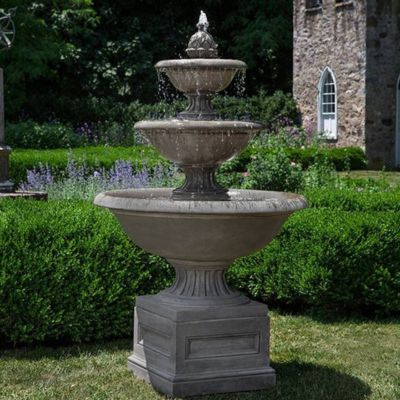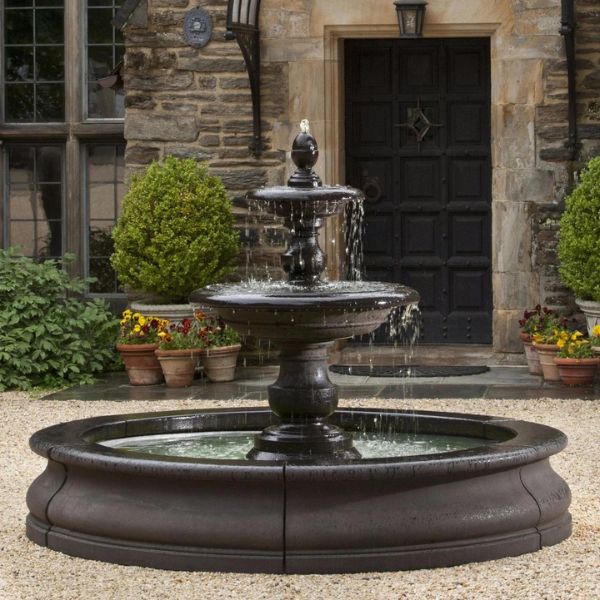Ever felt like your garden could use a touch of magic? Discover what makes a good yard fountain the standout centerpiece. Dive in and transform your space!
Choosing the right yard fountain can transform your garden into a peaceful retreat. The key features include the size that fits your space, the material that withstands weather, and a design that complements your garden's style. It should also be easy to maintain and cost-effective over time.
As we integrate a fountain into our yard, it is important to consider how it complements our garden design. The installation should achieve balance and symmetry, considering the dimensions of our space and the natural flow of movement. Whether it's a freestanding piece that serves as a commanding centerpiece or a more subdued tabletop fountain, adding subtle charm, the selection of a fountain is a personal and crucial step in crafting our ideal outdoor sanctuary.
Understanding Yard Fountains

When we consider what elevates a yard's aesthetic and ambiance, yard fountains often come to the forefront due to their visual appeal and the calming sound of moving water.
Fountain Basics
- Material Choices: Solid materials are fundamental for durability in outdoor fountains. Materials that don’t quickly disintegrate, like stone or metal, are preferred as they ensure longevity and prevent damage to crucial parts such as the water pump.
- Maintenance: Regular upkeep is essential to maintaining a water fountain's functionality and appearance. We recommend considering the level of care each fountain type may require before deciding. For instance, metal fountains might need more attention to prevent tarnish, while stone options might blend with the environment but still require cleaning to avoid algae build-up.
Fountain Types
When we discuss yard fountains, we often categorize them by their design and how they're integrated into the landscape. Here, we'll explore some specific fountain types that can elevate a garden's ambiance and decor.
- Wall Fountains: Wall fountains are an excellent choice for compact spaces, effortlessly adding elegance and motion to a vertical plane. We mount them on walls with a basin below to catch the water. These fountains create a serene backdrop and are often used to enhance the privacy and intimacy of a yard.
- Tiered Fountains: Tiered fountains stand out for their classic design and cascading water effect over multiple levels. It is visually appealing and relaxing due to the sound of flowing water. A tiered fountain serves as a magnificent centerpiece, embodying a traditional aesthetic that can complement a variety of outdoor spaces.
- Pool Fountains: We often incorporate pool fountains into larger bodies of water like garden pools or ponds to add a dynamic water feature. They can be simple spouts or elaborate sculptures that spray water, creating a lively interaction between the sculpture and the pool, including live aquatic life.
- Tabletop and Pedestal Fountains: For more intimate or private garden areas, tabletop and pedestal fountains are ideal. These smaller fountains can be placed on top of garden tables or stand-alone on pedestals, often resembling larger structures in miniature form. They are perfect for adding a touch of water music without needing a large footprint.
- Large Fountains: Large fountains are unmatched for us, with ample space and a desire to make a statement. These can range from grand, sculptural installations to expansive tiered designs that dominate the landscape with their presence and the resonant sound of water.
Each fountain type offers a distinct characteristic that can complement different garden or yard settings. Considering the space available and the ambiance we aim to create, we must choose.
Design Considerations

When choosing a fountain for your yard, several factors can influence aesthetics and functionality. We'll discuss the importance of selecting the right size, style, material, and colors and how to integrate your fountain with the surrounding environment effectively.
Choosing the Right Size
The size of the fountain should complement the scale of your yard. A freestanding fountain could serve as a striking centerpiece in a large space, while smaller yards benefit from the subtlety of tabletop fountains. Our decision impacts the visual balance and the ease of movement within the space.
Selecting a Style
Fountains come in various styles, from rustic stone fountains that blend with natural landscapes to sleek modern fountains that add a touch of sophistication. The chosen style should harmonize with your home's architecture and garden design to create cohesive visual interest.
Material Matters
The durability and appearance of your fountain are primarily dictated by its material. Stone and concrete fountains are robust and classic, while metal can introduce a brighter or more sculptural element. Glass may be used for a contemporary feel but requires more maintenance.
Color and Texture
The fountain's color should align with the yard's palette to enhance the area rather than distract. Neutral colors often work well, providing a timeless appeal. Textures can add depth — a smooth finish may convey a more modern look, whereas rough textures suggest a rustic feel.
Incorporating Surrounding Elements
We have to consider the relationship between the fountain and the landscape. Symmetry and balance are key; terra-cotta pots filled with plants can complement a round brick basin. The fountain's positioning should contribute to a harmonious blend with the yard's existing elements.
Benefits Of Yard Fountain

Yard fountains, with their aesthetic and functional attributes, can significantly enhance the quality of an outdoor space. Here's how they contribute to both curb appeal and creating a soothing auditory environment:
Curb Appeal
- Visual Attraction: Yard fountains serve as striking visual features. Whether a classic tiered design or a modern sculptural piece, a fountain can act as a focal point that draws attention and admiration.
- Landscaping Enhancements: Fountains can be incorporated into a variety of landscaping styles. They often become the centerpiece around which other elements like plants, flowers, and garden paths are arranged.
- Increases Property Value: A well-maintained fountain can increase the property value. It enhances the home's overall appeal, making it more attractive to potential buyers.
Soothing Sounds to Drown Out Neighbors or Traffic Pollution
- Sound Barrier: The continuous flow and splash of water in a fountain can mask unwanted noises from the neighborhood or nearby streets. This creates a more peaceful outdoor environment.
- Stress Reduction: The sound of running water is universally calming and can significantly reduce stress levels. It provides a tranquil backdrop for relaxation and contemplation in your garden.
- Wildlife Attraction: The gentle sounds of a fountain also attract birds and other wildlife, which adds a pleasant, natural dimension to the garden ambiance.
These benefits make yard fountains valuable to any outdoor space for their beauty and functional advantages in improving the living environment.
Where to Place Them
When we consider adding a fountain to our yard, we focus on locations that enhance our outdoor space's aesthetic appeal. The right placement can complement existing landscaping and create a serene environment.
Circular Driveway
Positioning a fountain in the center of a circular driveway creates an impressive focal point. It's ideal for large driveways with ample space, allowing the fountain to be encircled by hedges or shrubs, which can add to its grandeur while blending seamlessly with the driveway's curvature.
Next to the Front Door
A fountain placed next to the front door can offer a warm welcome to guests. In this spot, choosing a design that complements the front door and house facade, potentially flanked by topiary or manicured shrubs for added symmetry and curb appeal, is essential.
Highlight a Front Walkway
We enhance a front walkway by installing a fountain along its path. This draws the eye and adds a sense of tranquility to the entrance of our home. Tall fountains may be paired with lower landscaping elements like ground cover or small trees to maintain an unobstructed view of our residence.
Maintenance and Upkeep
Maintenance and care are very important to make sure that our yard fountain keeps working well and improving our outdoor space. Attending to regular cleaning and preventing algae growth are essential practices, as is taking special care during winter months.
Regular Cleaning
To preserve our fountain's beauty and functionality, we must clean it regularly. This involves:
- Surface Cleaning: To clean the fountain, use a soft cloth and light dish soap to wipe down the surfaces.
- Pump Maintenance: Every few weeks, remove the pump and use a soft brush or cloth to clear away any build-up of debris.
- Deep Cleaning: Quarterly, drain the fountain and perform a more thorough cleaning, scrubbing accessible areas with a soft brush or sponge to prevent any scale from forming.
Preventing Algae Growth
Algae can quickly tarnish the appearance of our fountain. Here's how we keep it at bay:
- Use of Clarifiers: Incorporate a water clarifier into the fountain’s water according to the product directions to discourage algae growth.
- Regular Water Treatment: Regularly add a scale and stain remover to the water, doubling the dosage if algae persist.
Winter Care
Our fountain requires extra attention during the cold season to avoid damage:
- Water Drainage: Before the onset of freezing temperatures, drain all water from the fountain to prevent cracking.
- Pump Storage: Remove and store the pump indoors to protect it from harsh winter conditions.
Adhering to these maintenance guidelines ensures our fountain remains an alluring centerpiece in our yard throughout the year.
Conclusion
In selecting the ideal yard fountain for our space, we've assessed various factors that contribute to their success. Our choices hinge on considering size, material, design, and maintenance.
Moreover, we recognize the importance of the fountain's integration with other elements in our space, such as lighting and surrounding plantings. By prioritizing these aspects, we ensure that our yard fountain is a visually striking feature and sustainable and enjoyable addition to our outdoor living space.
Frequently Asked Questions
This section covers some of the most common questions about selecting, maintaining, and designing yard fountains to help guide you through the process.
How do I choose an outdoor fountain?
When choosing an outdoor fountain, size and scale are essential. We recommend selecting a size that complements your space without overwhelming it and choosing a design that reflects your personal style and your garden's aesthetic.
What is the best material for outdoor fountains?
Resin casts, concrete, and metal are some of the best materials for outdoor waterfalls because they can stand up to the weather and don't need much upkeep. These durable materials often come in various finishes to match your garden's decor.
Should a water fountain be in the sun or shade?
A water fountain can be placed in the sun or shade, but remember that constant exposure to sunlight might lead to algae growth in the water. Placement largely depends on your garden's design and the type of fountain material.
How do I keep my backyard fountain water clean?
To maintain clarity and cleanliness, use a combination of consistent water circulation, a filtration system, and regular cleaning. Some people also use safe water additives to prevent algae and maintain water quality.
What are some design ideas for garden water fountains?
Some well-loved design ideas include freestanding statues, fountains incorporated into ponds, and discreet wall-mounted options. We can also opt for a fountain as a centerpiece or a subtle addition that blends into the natural setting.
What factors should I consider for a water fountain in my front yard?
Think about the size of the front yard, the style of your house, and how much maintenance you are willing to do. The fountain should be proportional to the space and fit cohesively with the landscape design.

